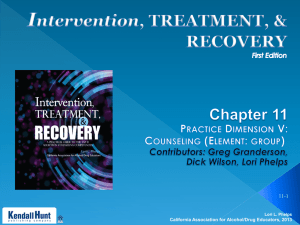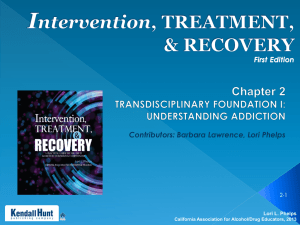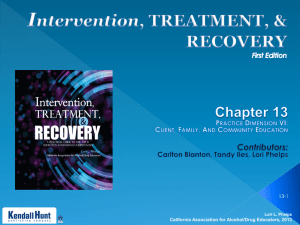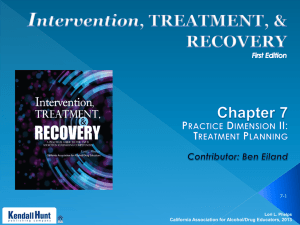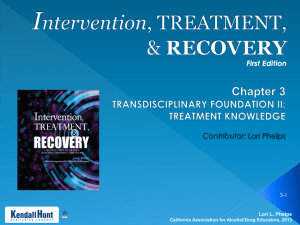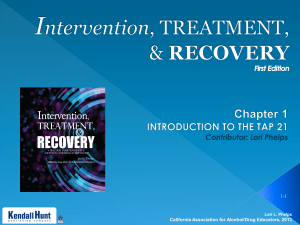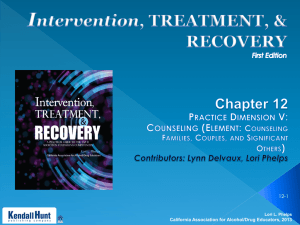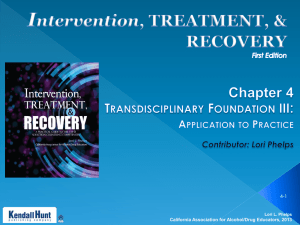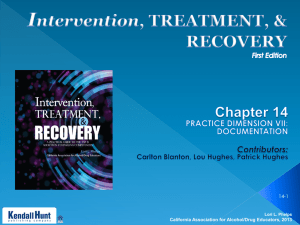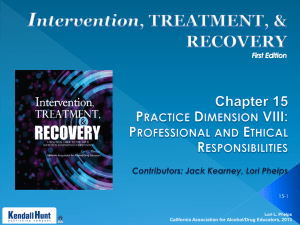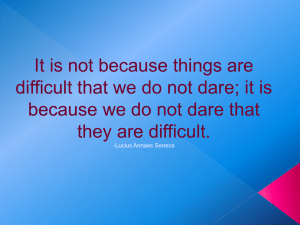Chapter 6 pptx - California Association for Alcohol/Drug Educators
advertisement
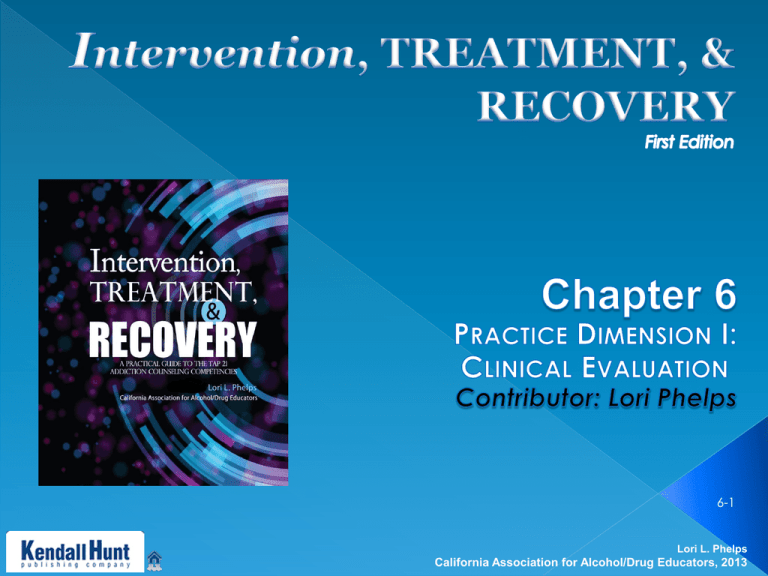
6-1 Lori L. Phelps California Association for Alcohol/Drug Educators, 2013 Establish rapport, including management of a crisis situation and determination of need for additional professional assistance. Strategies for Establishing Rapport › Consider stages of Change › 80% of substance abusers are currently in pre-contemplation or contemplation › Offer relevant information in a supportive and empathetic manner 6-2 Lori L. Phelps California Association for Alcohol/Drug Educators, 2013 Opening Sessions › Establish rapport and trust › Explore events that precipitated treatment entry › Commend clients for coming Motivational Approach 6-3 Lori L. Phelps California Association for Alcohol/Drug Educators, 2013 First to ask the client for permission to address the topic of change › Shows respect for client’s autonomy Explain how you and/or your program operates › Try not to overwhelm › Explain assessments › Confidentiality › Let client do most of the talking (feelings and hopes) 6-4 Lori L. Phelps California Association for Alcohol/Drug Educators, 2013 Express empathy through reflective listening. Develop discrepancy between clients’ goals or values and their current behavior. Avoid argument and direct confrontation. Adjust to client resistance rather than opposing it directly. Support self-efficacy and optimism. 6-5 Lori L. Phelps California Association for Alcohol/Drug Educators, 2013 Gather data systematically from the client and other available collateral sources, using screening instruments and other methods that are sensitive to age, developmental level, culture, and gender. At a minimum, data should include current and historic substance use; health, mental health, and substancerelated treatment histories; mental and functional statuses; and current social, environmental, and/or economic constraints. 6-6 Lori L. Phelps California Association for Alcohol/Drug Educators, 2013 A process by which the counselor, the client, and available significant others review the current situation, symptoms, and other available information to determine the most appropriate initial course of action, given the client’s needs and characteristics and the available resources within the community (CSAT, 2006a, p. 39) 6-7 Lori L. Phelps California Association for Alcohol/Drug Educators, 2013 National Survey on Drug Use and Health (NSDUH) 2009 › only 7.4 percent of people with co-occurring disorders receive treatment for both substance use disorders (SUDs) and mental illness (MI). › People with co-occurring disorders are far more likely to get treatment for MI than for SUDs. People with severe mental illness (SMI) are more likely than those with mild MI to have an SUD 6-8 Lori L. Phelps California Association for Alcohol/Drug Educators, 2013 a formal process of testing to determine whether a client does or does not warrant further attention The screening process for COD seeks to answer a Yes or No question: Does the substance abuse (or mental health) client being screened show signs of a possible mental health (or substance abuse) problem? 6-9 Lori L. Phelps California Association for Alcohol/Drug Educators, 2013 Does not necessarily identify what kind of problem the person might have or how serious it might be Determines whether or not further assessment is warranted Can be conducted by counselors using their basic counseling skills. Seldom any legal or professional restraints on who can be trained to conduct a screening. 6-10 Lori L. Phelps California Association for Alcohol/Drug Educators, 2013 Suicide is a leading cause of death among people who abuse alcohol and drugs (Wilcox, Conner, & Caine, 2004). › Individuals treated for alcohol abuse or dependence are at about 10 times greater risk to eventually die by suicide (than general population) › people who inject drugs are at about 14 times greater risk for eventual suicide Individuals with substance use disorders are also at elevated risk for suicidal ideation and suicide attempts 6-11 Lori L. Phelps California Association for Alcohol/Drug Educators, 2013 For Suicide Assessment Gather information Access supervision Take responsible action Extend the action Document all actions you take › what information you obtained › when and what actions were taken › how you followed up 6-12 Lori L. Phelps California Association for Alcohol/Drug Educators, 2013 6-13 Lori L. Phelps California Association for Alcohol/Drug Educators, 2013 Introducing the topic › I have a few questions to ask you about suicidal thoughts and behaviors. Screening for suicidal thoughts › Have you ever thought about carrying out suicide? Screening for suicide attempts › Have you ever tried to take your own life? 6-14 Lori L. Phelps California Association for Alcohol/Drug Educators, 2013 Understand the addiction professional’s obligations to adhere to ethical and behavioral standards of conduct in the helping relationship. 6-15 Lori L. Phelps California Association for Alcohol/Drug Educators, 2013 Select and use a comprehensive assessment process that is sensitive to age, gender, racial, and ethnic culture, and disabilities that includes but is not limited to: › History of alcohol and drug use › Physical health, mental health, and › › › › addiction treatment histories Family issues Work history and career issues History of criminality Psychological, emotional, and worldview concerns . . . continued 6-16 Lori L. Phelps California Association for Alcohol/Drug Educators, 2013 › Current status of physical health, mental › › › › › › health, and substance use Spiritual concerns of the client Education and basic life skills Socioeconomic characteristics, lifestyle, and current legal status Use of community resources Treatment readiness Level of cognitive and behavioral functioning 6-17 Lori L. Phelps California Association for Alcohol/Drug Educators, 2013 An ongoing process through which the counselor collaborates with the client and others to gather and interpret information necessary for planning treatment and evaluating client progress. › Screening is a process for evaluating the possible presence of a particular problem. › Assessment is a process for defining the nature of that problem and developing specific treatment recommendations for addressing the problem. 6-18 Lori L. Phelps California Association for Alcohol/Drug Educators, 2013 6-19 Lori L. Phelps California Association for Alcohol/Drug Educators, 2013 Project CORK: http://www.projectcork.org/clinical_tools /index.html Substance Use Screening & Assessment Instruments Database: http://lib.adai.washington.edu/instrumen ts/ 6-20 Lori L. Phelps California Association for Alcohol/Drug Educators, 2013 Alcohol and Drug Use Screening, Intervention, and Referral: Changing the Nation’s Approach to Comprehensive Healthcare http://store.samhsa.gov/product/Alcohol-andDrug-Use-Screening-Intervention-and-ReferralChanging-the-Nation-s-Approach-toComprehensive-Healthcare-DVD-/DVD183 6-21 Lori L. Phelps California Association for Alcohol/Drug Educators, 2013 Project CORK: http://www.projectcork.org/clinical_tools/index.html AUDIT (Alcohol Use Disorder Identification Test) MAST (Michigan Alcoholism Screening Test) AUDIT-C (Consumption) MAST-G (Geriatric) AUDIT-PC (Primary Care) Brief MAST CAGE Short MAST CRAFFT Short MAST-G DAST (Drug Abuse Screening Test) T-Ace Fagerstrom Test for Nicotine Dependence Trauma Index TWEAK 6-22 Lori L. Phelps California Association for Alcohol/Drug Educators, 2013 Simple Screening Instrument for Substance Abuse (SSI-SA) Mental Health Screening Form-III 6-23 Lori L. Phelps California Association for Alcohol/Drug Educators, 2013
